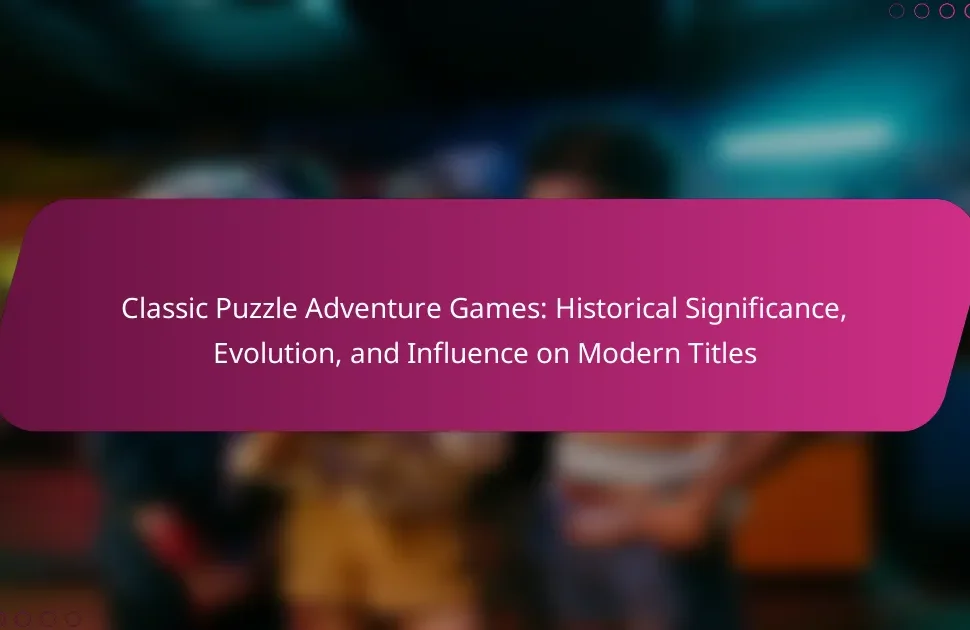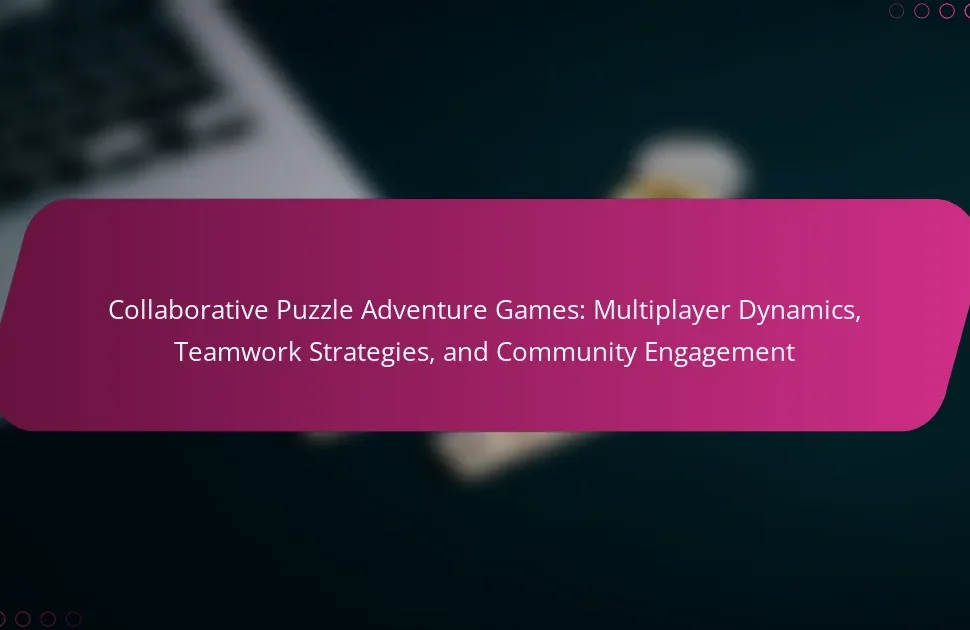Narrative-driven puzzle adventure games enhance player engagement and emotional impact through immersive storytelling and critical thinking challenges. These games create deep connections with characters and plots, making puzzles integral to the narrative. Players experience a range of emotions, from joy to frustration, as they navigate complex stories. Additionally, understanding player demographics helps designers tailor experiences that foster emotional investment and satisfaction.
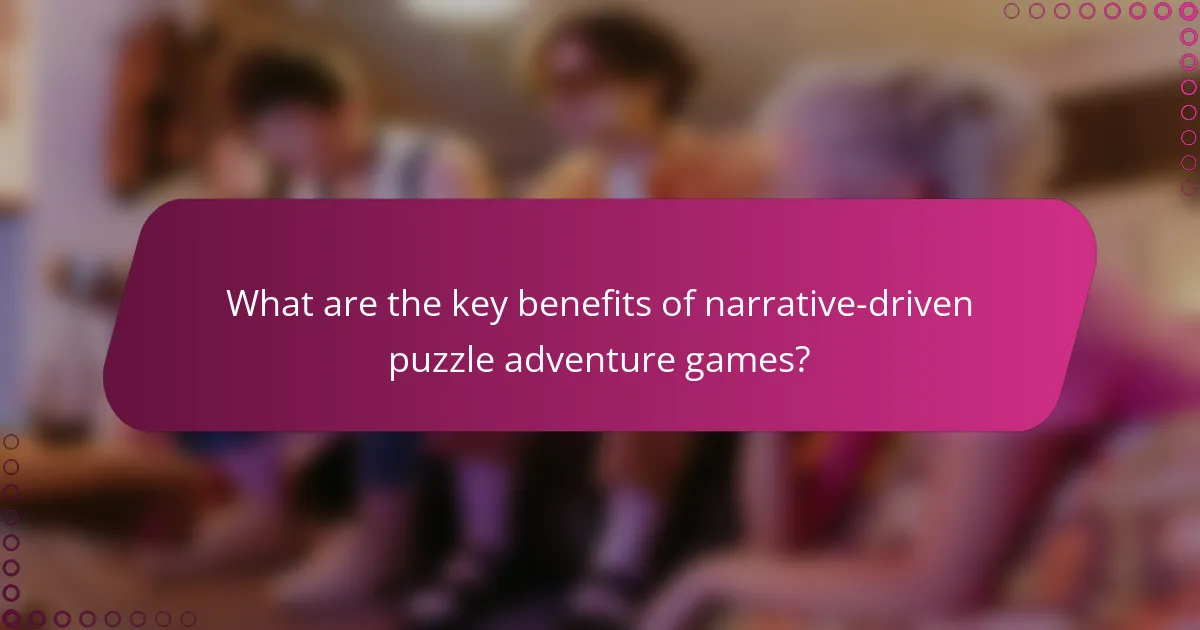
What are the key benefits of narrative-driven puzzle adventure games?
Narrative-driven puzzle adventure games offer significant benefits, enhancing player engagement and emotional impact. They immerse players in rich stories, promoting deeper connections to characters and plotlines.
The puzzles stimulate critical thinking, encouraging players to solve challenges that are intricately tied to the narrative. This integration fosters a sense of accomplishment and progression, enhancing the overall gaming experience.
Additionally, these games often evoke a range of emotions, from joy to suspense, making the gameplay more memorable. The unique combination of storytelling and problem-solving creates a compelling atmosphere that keeps players invested in the journey.
As a result, narrative-driven puzzle adventure games not only entertain but also provide cognitive and emotional benefits, making them a valuable genre in the gaming landscape.
How do these games enhance cognitive skills?
Narrative-driven puzzle adventure games enhance cognitive skills by promoting critical thinking, problem-solving, and memory retention. Players must analyze complex narratives and solve intricate puzzles, which stimulates mental agility. These games often require strategic planning and decision-making, further strengthening cognitive abilities. Engaging with emotionally rich stories also enhances empathy and social cognition, making the gaming experience both entertaining and intellectually beneficial.
What role does storytelling play in player retention?
Storytelling significantly enhances player retention by creating emotional connections. Engaging narratives foster immersion, making players more invested in the game. Players are likely to return for sequels or expansions due to their attachment to characters and story arcs. A strong narrative can also encourage social sharing, increasing community engagement. Ultimately, storytelling transforms gameplay into a memorable experience that keeps players returning.
How can emotional engagement impact overall player satisfaction?
Emotional engagement significantly enhances overall player satisfaction in narrative-driven puzzle adventure games. Players connect deeply with characters and storylines, fostering investment in the game. This emotional connection leads to increased immersion, making challenges feel more rewarding. As a result, players are more likely to enjoy the gameplay experience and feel fulfilled upon completion. Engaging narratives often evoke a range of emotions, from joy to tension, enriching the player’s journey and enhancing their overall satisfaction.
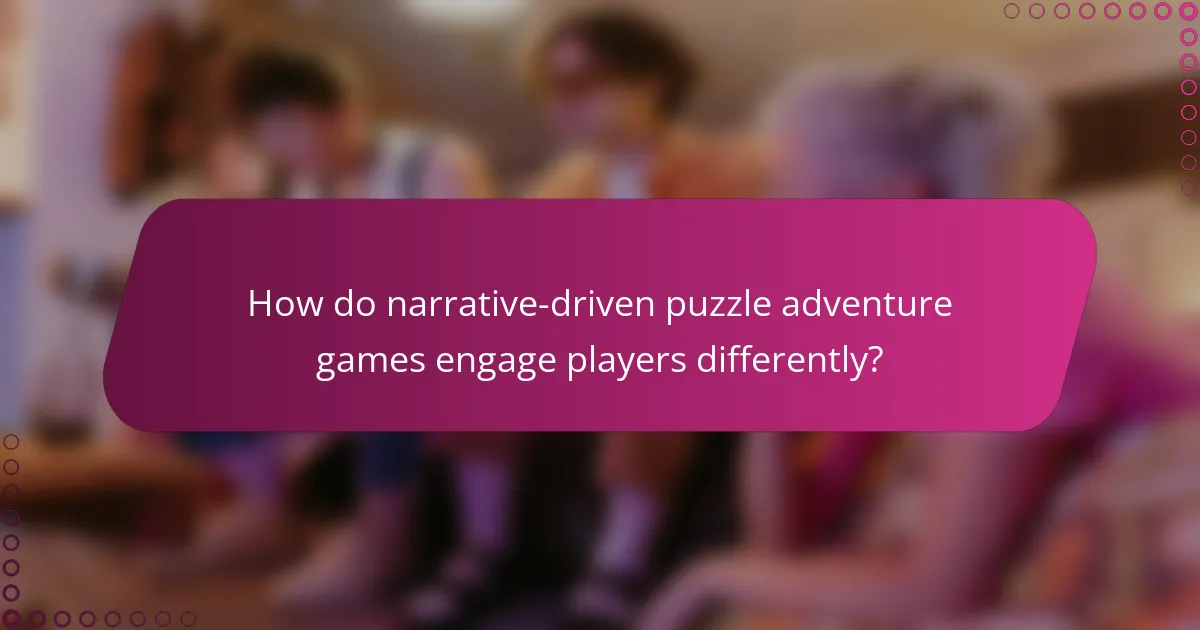
How do narrative-driven puzzle adventure games engage players differently?
Narrative-driven puzzle adventure games engage players by combining storytelling with problem-solving. This integration enhances immersion and emotional investment, allowing players to connect deeply with characters and plots.
The unique attribute of these games is their ability to weave puzzles into the narrative, making challenges feel integral to the story. For example, solving a puzzle may reveal crucial plot points or character backstories, enhancing player motivation.
Moreover, these games often utilize branching narratives, offering players choices that impact the storyline. This rare attribute fosters a sense of agency, encouraging players to explore different outcomes and engage with the game world more fully.
As a result, the emotional impact is significant, with players experiencing a range of feelings from frustration to satisfaction, driven by both the narrative and the puzzles. This dual engagement model sets narrative-driven puzzle adventure games apart from other genres.
What mechanics are unique to this genre that foster engagement?
Narrative-driven puzzle adventure games engage players through immersive storytelling, challenging puzzles, and emotional connections. These mechanics encourage exploration and critical thinking while fostering a sense of achievement. Unique attributes include character-driven narratives that adapt based on player choices, enhancing emotional investment. Additionally, the integration of environmental storytelling adds depth, allowing players to uncover lore and backstory through interaction.
How do player choices influence narrative outcomes?
Player choices significantly shape narrative outcomes in narrative-driven puzzle adventure games by affecting plot progression and character development. These choices create a sense of agency, allowing players to influence the story’s direction and emotional tone. For instance, decisions may lead to different endings, character relationships, or gameplay challenges, enhancing player engagement. As a result, the emotional impact of the game is amplified, fostering a deeper connection between the player and the narrative. This interplay of choice and consequence is a core attribute of the genre, enriching the overall gaming experience.
Which elements of gameplay contribute to immersive experiences?
Narrative-driven puzzle adventure games create immersive experiences through engaging storytelling, interactive environments, and emotional connections. These elements enhance player engagement and foster deeper emotional impacts.
Strong narratives provide context and purpose, guiding players through challenges. Interactive environments allow players to explore and solve puzzles, reinforcing immersion. Emotional connections arise from character development and relatable themes, making players feel invested in the outcome.
These games often utilize unique attributes, such as non-linear storytelling, to differentiate experiences. As a result, players enjoy a rich tapestry of gameplay that captivates and resonates long after the game ends.

What emotional impacts do players experience while playing these games?
Players experience a range of emotional impacts while engaging with narrative-driven puzzle adventure games. These games often evoke feelings of joy, frustration, and satisfaction as players navigate complex stories and solve intricate puzzles. The immersive narratives create a deep emotional connection, allowing players to empathize with characters and invest in their journeys. As a result, players may experience catharsis, relief, or even a sense of accomplishment upon completing challenges. This emotional engagement enhances overall player satisfaction and retention, making the gaming experience more memorable and impactful.
How do narrative elements evoke empathy and connection?
Narrative elements evoke empathy and connection by immersing players in relatable experiences. Through character development, players form emotional bonds, enhancing engagement. Story arcs enable players to experience challenges and triumphs, fostering a sense of shared journey. This emotional investment deepens the overall impact of narrative-driven puzzle adventure games.
What psychological effects can arise from solving puzzles within a narrative context?
Solving puzzles within a narrative context can enhance cognitive skills, emotional engagement, and social interaction. Players often experience increased problem-solving abilities as they navigate challenges, fostering critical thinking. The emotional impact is significant; players may feel a sense of accomplishment and satisfaction upon completing puzzles, contributing to positive mental health. Additionally, narrative-driven puzzles can evoke empathy through character-driven stories, deepening player connection to the game’s themes. These psychological effects create a more immersive and rewarding gaming experience.
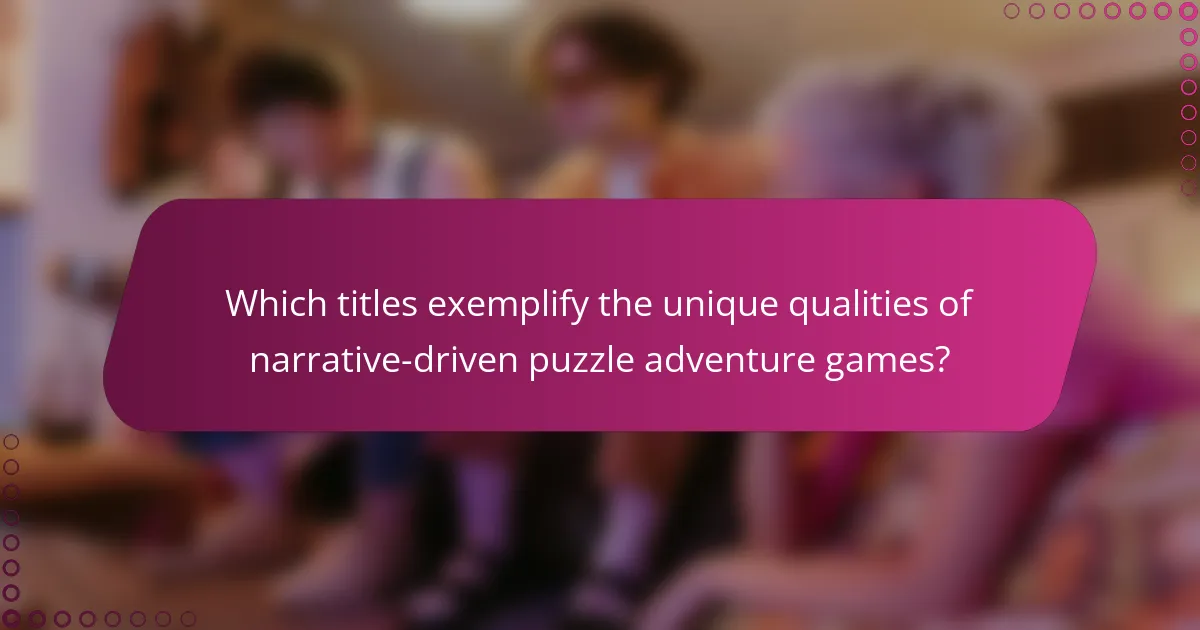
Which titles exemplify the unique qualities of narrative-driven puzzle adventure games?
Titles that exemplify unique qualities of narrative-driven puzzle adventure games include “The Witness,” “Life is Strange,” and “Oxenfree.” These games blend intricate puzzles with deep storytelling, enhancing player engagement and emotional impact. Each title offers distinctive narrative styles, character development, and immersive worlds that resonate with players. “The Witness” features environmental puzzles that challenge perception, while “Life is Strange” incorporates time manipulation to influence the story. “Oxenfree” utilizes dialogue choices to shape relationships, showcasing the emotional depth of player interactions.
What differentiates critically acclaimed games from lesser-known titles?
Critically acclaimed narrative-driven puzzle adventure games often excel in storytelling, immersive gameplay, and emotional depth. These elements foster player engagement and create lasting memories. High-quality narratives enhance emotional impact, while innovative puzzles challenge players, distinguishing these titles from lesser-known games.
How do cultural narratives influence game design and player experience?
Cultural narratives significantly shape game design and player experience by providing context and emotional depth. These narratives influence gameplay mechanics, character development, and environmental storytelling, enhancing player immersion.
In narrative-driven puzzle adventure games, cultural themes can dictate the puzzles’ complexity and the emotional responses they evoke. For instance, a game rooted in a specific culture may incorporate traditional folklore, impacting player engagement by resonating with familiar stories.
Moreover, cultural narratives create unique attributes in games, offering players diverse perspectives and experiences. This differentiation fosters deeper connections between players and the game world, enhancing the overall emotional impact of the gameplay.
As a result, integrating cultural narratives in game design leads to richer player experiences, promoting engagement and emotional resonance that can elevate the gaming experience beyond mere entertainment.
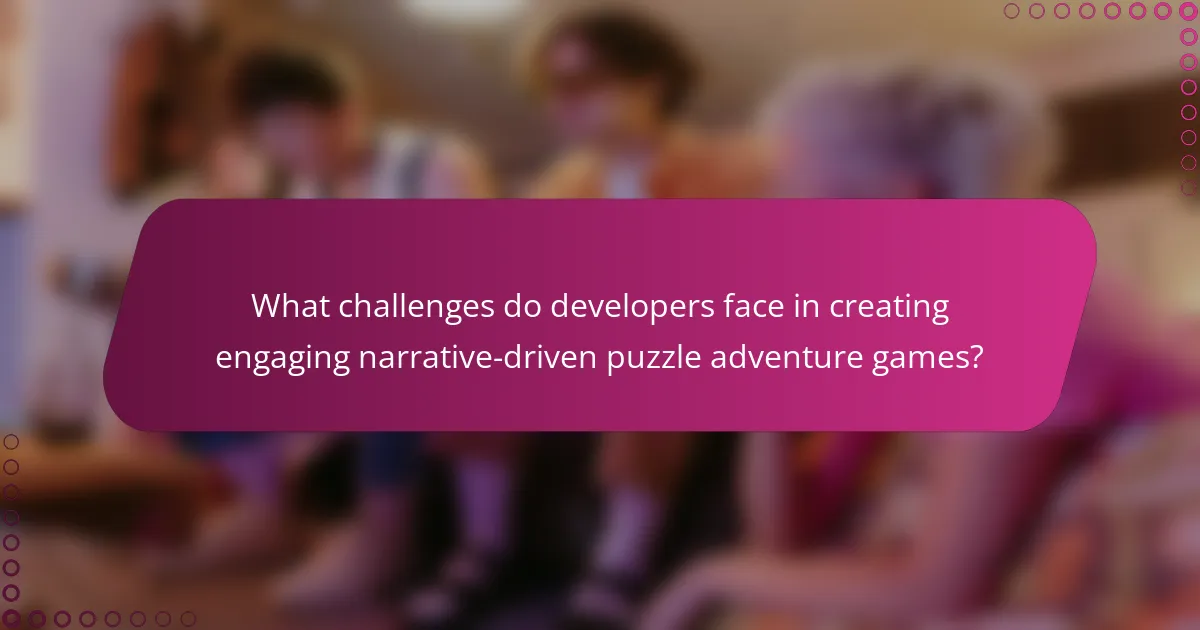
What challenges do developers face in creating engaging narrative-driven puzzle adventure games?
Developers face several challenges in creating engaging narrative-driven puzzle adventure games. These include balancing story depth with gameplay mechanics, ensuring puzzles align with the narrative, and maintaining player immersion throughout the experience.
Creating a compelling narrative requires intricate world-building and character development, which can be resource-intensive. Developers must also design puzzles that are not only challenging but also enhance the story rather than distract from it. This alignment is crucial for player engagement, as disjointed gameplay can lead to frustration.
Moreover, developers often struggle with pacing, as they need to manage the flow of narrative and gameplay effectively. Ensuring that players remain emotionally invested while solving puzzles is a delicate balance that can significantly impact the overall player experience.
How do budget constraints affect storytelling and gameplay mechanics?
Budget constraints limit resources, impacting storytelling depth and gameplay mechanics. Developers often simplify narratives and mechanics to fit financial limitations. This can lead to less immersive experiences, reducing player engagement. However, creative constraints can inspire innovation, resulting in unique gameplay solutions. Balancing budget and creativity is crucial for narrative-driven puzzle adventure games.
What are common pitfalls in balancing narrative and puzzle difficulty?
Common pitfalls in balancing narrative and puzzle difficulty include misalignment between story progression and puzzle complexity, leading to player frustration. Excessively challenging puzzles can disrupt immersion, while overly simplistic ones may diminish engagement. Additionally, failing to provide context for puzzles can alienate players. Consistent feedback and gradual difficulty scaling are essential for maintaining player interest.
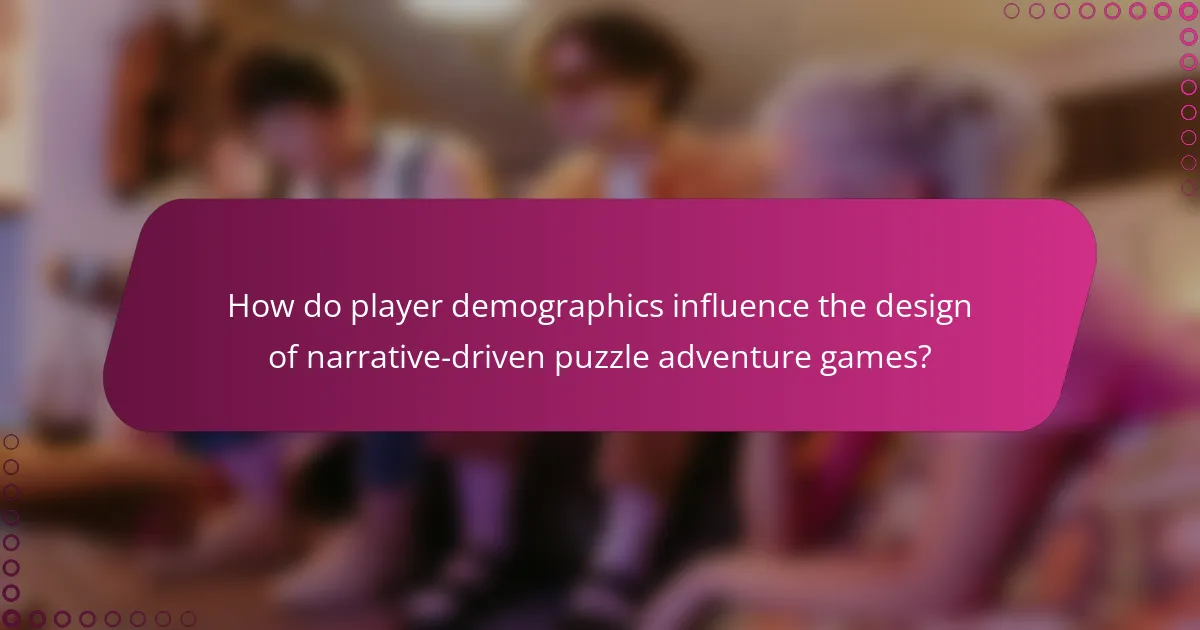
How do player demographics influence the design of narrative-driven puzzle adventure games?
Player demographics significantly shape the design of narrative-driven puzzle adventure games. Designers consider age, gender, cultural background, and gaming experience to enhance player engagement and emotional resonance.
Younger players often prefer fast-paced narratives with relatable characters, while older demographics may appreciate complex stories and deeper themes. Gender influences preferences in character representation and storylines, with diverse narratives appealing to a broader audience. Cultural backgrounds impact the themes and symbols used, ensuring relevance and relatability.
Understanding these demographics allows designers to create tailored experiences that increase immersion and satisfaction. Engaging storylines and puzzles that resonate with players’ backgrounds enhance emotional impact, fostering a stronger connection to the game.
What trends are emerging in preferences among different age groups?
Emerging trends in preferences among different age groups indicate a growing interest in narrative-driven puzzle adventure games. Younger players favor immersive storytelling and character development, while older players appreciate cognitive challenges and nostalgia.
Younger audiences prioritize emotional engagement and interactive narratives, often seeking games that offer rich, story-driven experiences. In contrast, older players tend to value gameplay mechanics that stimulate critical thinking and problem-solving. This divergence highlights the unique attributes of age-related gaming preferences.
As a result, game developers are increasingly focusing on creating titles that cater to these distinct preferences, blending engaging narratives with challenging puzzles. This approach not only enhances player engagement but also fosters emotional connections across various age demographics.
How does cultural background shape player expectations and experiences?
Cultural background significantly influences player expectations and experiences in narrative-driven puzzle adventure games. Players from different cultures bring unique perspectives, values, and storytelling traditions that shape their engagement with game narratives.
For example, players from collectivist cultures may prioritize community and collaboration in gameplay, while those from individualistic cultures may focus on personal achievement and self-expression. This cultural lens affects how players interpret character motivations, plot developments, and emotional connections within the game.
Moreover, cultural familiarity with specific themes, symbols, or narrative structures can enhance immersion and emotional impact. Games that resonate with a player’s cultural context can foster deeper connections and more meaningful experiences.
Understanding these cultural dynamics is essential for developers aiming to create inclusive and engaging narrative-driven puzzle adventure games that cater to a diverse audience.

What are the best practices for maximizing player engagement in these games?
To maximize player engagement in narrative-driven puzzle adventure games, focus on immersive storytelling, interactive gameplay, and emotional connection.
1. Develop a compelling narrative that captivates players and encourages exploration.
2. Incorporate challenging puzzles that require critical thinking and problem-solving skills.
3. Use character development to create emotional investment in the story and outcomes.
4. Provide meaningful choices that impact the narrative, enhancing player agency.
5. Foster community interaction through forums or social media to share experiences and strategies.
6. Regularly update content with new puzzles and storylines to maintain interest.
How can developers effectively integrate feedback into game design?
Developers can effectively integrate feedback into game design by actively engaging with players and iterating on their input. Establish a feedback loop through playtesting sessions, surveys, and community forums.
Utilize qualitative feedback to enhance narrative depth, puzzle complexity, and player engagement. Analyze player behavior data to identify areas for improvement. Prioritize changes based on player impact and feasibility to ensure a balanced development process.
Emphasize emotional impact by incorporating player suggestions that resonate with their experiences. This approach fosters a collaborative environment, enhancing the overall quality of narrative-driven puzzle adventure games.
What strategies can enhance emotional resonance in storytelling?
Engaging emotional resonance in storytelling can be enhanced through several strategies. Deep character development allows players to form connections with protagonists, fostering empathy. Layered narratives introduce complexity, encouraging players to invest emotionally in outcomes. Environmental storytelling immerses players in rich worlds, evoking feelings through visual and auditory cues. Player choices that impact story outcomes create a sense of agency, heightening emotional stakes. Finally, the use of music and sound design can amplify emotional moments, reinforcing the narrative impact.
What common mistakes should developers avoid when crafting narratives?
Developers should avoid common mistakes like neglecting character development, failing to establish a coherent plot, and overlooking player feedback. These errors can diminish player engagement and emotional impact in narrative-driven puzzle adventure games.
Another critical mistake is creating overly complex puzzles that hinder narrative flow. Puzzles should enhance storytelling, not disrupt it. Additionally, developers often underestimate the importance of pacing; a well-timed narrative keeps players invested.
Ignoring thematic consistency can also lead to disjointed experiences. Every element should align with the game’s core themes, ensuring a unified player experience. Lastly, failing to test narratives with real players can result in missed opportunities for improvement and deeper emotional connections.



